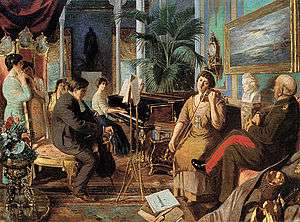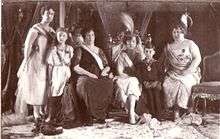Şehsuvar Kadın
| Şehsuvar Kadın | |||||
|---|---|---|---|---|---|
 An 1898 painting of Şehsuvar Kadınefendi, painted by her husband | |||||
| Caliphal consort of the Ottoman Caliphate | |||||
| Tenure | 19 November 1922 - 3 March 1924 | ||||
| Born |
2 May 1881 Istanbul, Ottoman Empire | ||||
| Died |
c. 1945 Paris, France | ||||
| Burial | Bobigny Cemetery | ||||
| Spouse | Abdülmecid II | ||||
| Issue | Şehzade Ömer Faruk | ||||
| |||||
| House | House of Osman (by marriage) | ||||
| Father | Ubykh Bey | ||||
| Religion | Sunni Islam | ||||


Şehsuvar Kadın (2 May 1881 - c. 1945) was the first wife of Abdülmecid II, the last Caliph of the Muslim world.
Life
Şehsuvar Kadın was born on 2 May 1881 in Istanbul. She belonged to the Ubykh clan of Circassia. Her personal name is not known. At a young age her father, himself attendant at the court, presented her in the imperial harem. She was renamed Şehsuvar and was given education, and lessons of painting and playing piano in the harem department of Şehzade Abdülmecid's harem. She had honey color eyes and long golden blonde hair.[1] Şehsuvar grew into a young lady in Şehzade Abdülmecid's harem, when at the age of fifteen, she was selected a bride for him, and married him on 22 December 1896, in the Ortaköy Palace, Istanbul. On 29 February 1898 she gave birth to her and Abdülmecid's only son, Şehzade Ömer Faruk.[2] On 4 March 1924 she followed her husband into exile, with the other members of the entourage. They moved firstly to Switzerland and then to France where they settled in Paris.
In paintings
In an 1898 work by Abdülmecid, Pondering/Goethe in the harem, Şehsuvar is shown reclining on a settee.[3] However, according to an interview with Fatma Neslișah Sultan Osmanoğlu on 26 May 2002, she said that the figure does not resemble her paternal grandmother Sehsuvar Kadın.[4] In another work of 1915, Harmony of the Harem/Beethoven in the Harem, by her husband, she is shown playing a violin.[3]
Death
She died in 1945, having outlived her husband by nearly one year, and was buried in the Muslim Bobigny cemetery in Paris.[1][2][5]
References
- 1 2 Harun Açba (2007). Kadın efendiler: 1839-1924. Profil. pp. 205–7. ISBN 978-9-759-96109-1.
- 1 2 Genealogy Of The Imperial Ottoman Family (2005)
- 1 2 Wendy M. K. Shaw (March 15, 2011). Ottoman Painting: Reflections of Western Art from the Ottoman Empire to the Turkish Republic. I.B.Tauris. pp. 85–8. ISBN 978-1-848-85288-4.
- ↑ Ömer Faruk Şerifoğlu (2004). Abdülmecid Efendi, Ottoman prince and painter. YKY. p. 103. ISBN 978-9-750-80883-8.
- ↑ Yılmaz Öztuna (1989). İslâm devletleri: devletler ve hanedanlar. Kültür Bakanlığı. ISBN 978-9-751-70469-6.
External links
- Laf Lafı Açıyor…Osmanlı Hanedanı ve Neslişah Sultan} (Turkish)
- SON HALİFE ABDÜLMECİT EFENDİ’NİN İLK EŞİ İNGİLİZ MİYDİ? (Turkish)